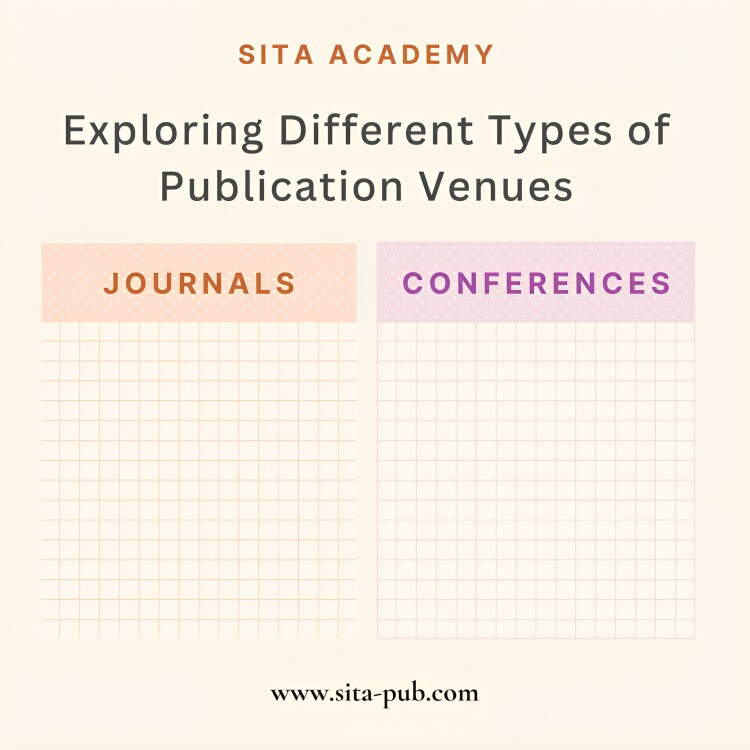Exploring Different Types of Publication Venues: Journals, Conferences


Publishing research is an important part of academic life. It allows scholars to share their findings and contribute to their fields. When deciding where to publish, two main options stand out: journals and conferences. Each option has its own processes, structures, advantages, and challenges. This article will explain both options in detail, including their processes, structures, and a comparison to help researchers make informed decisions.

Journals are periodicals that publish scholarly articles focused on specific academic fields. They serve as a formal platform for researchers to present their work and reach an audience interested in their subject matter. Journals can be subscription-based or open access, affecting how readers access the published research.
Submission: Authors submit their articles through an online system. The manuscript usually includes several sections, such as the title, abstract, introduction, methods, results, discussion, conclusion, and references.
Peer Review: After submission, the article goes through a peer review process. This means that experts in the field evaluate the work for quality, originality, and relevance. Reviewers provide feedback, which may include suggestions for improvement.
Revisions: Authors may need to revise their articles based on the reviewers' comments. This step is crucial for ensuring the research meets the journal's standards.
Acceptance: Once revisions are made, the article is resubmitted. If it meets all criteria, it is accepted for publication.
Publication: After acceptance, the article is scheduled to be published in a specific issue of the journal. Many journals also provide online access to articles, increasing their visibility.
A typical journal article follows a structured format:
Title and Abstract: A brief summary of the research and the main findings.
Introduction: Background information and the purpose of the study.
Methodology: A detailed explanation of how the research was conducted.
Results: Presentation of the findings, often with tables and figures for clarity.
Discussion: Interpretation of results and their implications.
Conclusion: A summary of the research and its importance.
References: A list of all works cited in the article.
Credibility: Journals are often seen as credible sources because of the rigorous peer review process.
Longer Format: Journals allow for more detailed discussion of research, providing a complete view of the study.
Targeted Audience: Articles reach a specialized audience interested in that specific field.
Longer Timeframe: The publication process can take a lot of time, often between 6 months and 2 years.
Lower Acceptance Rates: Many reputable journals have acceptance rates between 10% and 30%, meaning fewer papers are published.

Conferences are events where researchers present their work, often through talks or poster sessions. They provide a platform for sharing ideas and receiving immediate feedback. Conferences can be focused on specific subjects or be interdisciplinary, attracting a variety of participants.
Call for Papers: Conferences invite researchers to submit abstracts or full papers based on specific topics.
Submission: Authors submit their work by a deadline, which can be an abstract or a full paper depending on the conference.
Review: Submitted papers are reviewed by a committee of experts who evaluate the relevance and quality of the research.
Notification: Authors receive notifications about whether their submissions are accepted or rejected.
Presentation: Accepted papers are presented at the conference, allowing for direct feedback and discussion.
Proceedings: Selected papers may be published in conference proceedings, which are collections of the papers presented at the conference.
A conference paper typically follows a simpler format than a journal article:
Abstract: A brief overview of the research.
Introduction: Contextual information and research questions.
Methodology: Summary of how the research was conducted.
Results: Key findings presented clearly.
Discussion: Brief interpretation of the results.
References: List of cited works.
Quick Feedback: Conferences provide immediate feedback on research, allowing authors to improve their work.
Networking Opportunities: Conferences help researchers connect with others in their field, leading to possible collaborations.
Higher Acceptance Rates: Acceptance rates for conferences are often higher, typically around 30% to 50%.
Limited Publication Space: Conference proceedings may have limited space, which can restrict the depth of research presented.
Less Rigorous Review: While conferences do have review processes, they may not be as thorough as those of journals.
When deciding where to publish, researchers should consider various factors, including the goals of their research, the desired audience, and the timeline for publication. Below is a comparison of journals and conferences based on several criteria:
Feature | Journals | Conferences |
Submission Type | Full papers | Abstracts or full papers |
Review Process | Peer-reviewed by experts | Reviewed by a committee |
Feedback | Detailed comments for revisions | Immediate feedback during presentations |
Publication | Published in specific journal issues | Published in conference proceedings (if accepted) |
Presentation | No presentation; solely written format | Presentations at the conference |
Networking | Limited opportunities for networking | High opportunities for networking |
Timeframe | Longer publication timeline (6 months to 2 years) | Shorter timeline, usually within a year |
Audience Reach | Targeted readership in specific fields | Broader audience, often interdisciplinary |
Acceptance Rate | Typically lower (10% to 30% depending on the journal) | Generally higher (30% to 50% depending on the conference) |
Time to Publication | 6 months to 2 years after acceptance | 3 to 12 months after acceptance |
Choosing the right place to publish research is important for researchers who want to share their work effectively. Journals offer a formal way to present research with a thorough review process, while conferences provide quicker feedback and chances to network. Each option has its strengths and challenges, and understanding these differences can help researchers decide where to publish based on their goals, timeline, and audience. By considering these factors, researchers can enhance the impact of their work and contribute meaningfully to their fields.
If you have any questions, inquiries, or would like to learn more about our services, please don't hesitate to reach out to us. Our dedicated team is ready to assist you.